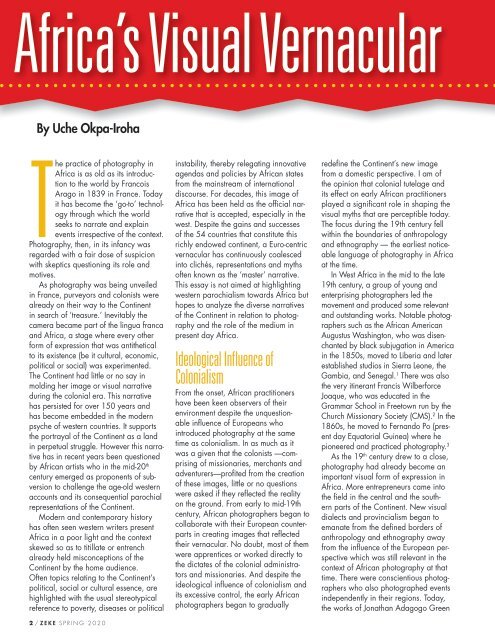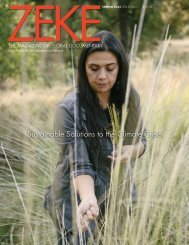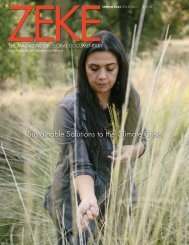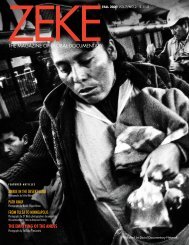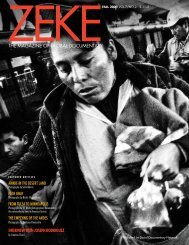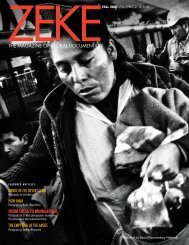Africa's Visual Vernacular by Uche Okpa-Iroha
From Spring 2020 special Africa issue of ZEKE magazine
From Spring 2020 special Africa issue of ZEKE magazine
You also want an ePaper? Increase the reach of your titles
YUMPU automatically turns print PDFs into web optimized ePapers that Google loves.
Africa’s <strong>Visual</strong> <strong>Vernacular</strong><br />
.......................................................<br />
By <strong>Uche</strong> <strong>Okpa</strong>-<strong>Iroha</strong><br />
The practice of photography in<br />
Africa is as old as its introduction<br />
to the world <strong>by</strong> Francois<br />
Arago in 1839 in France. Today<br />
it has become the ‘go-to’ technology<br />
through which the world<br />
seeks to narrate and explain<br />
events irrespective of the context.<br />
Photography, then, in its infancy was<br />
regarded with a fair dose of suspicion<br />
with skeptics questioning its role and<br />
motives.<br />
As photography was being unveiled<br />
in France, purveyors and colonists were<br />
already on their way to the Continent<br />
in search of ‘treasure.’ Inevitably the<br />
camera became part of the lingua franca<br />
and Africa, a stage where every other<br />
form of expression that was antithetical<br />
to its existence (be it cultural, economic,<br />
political or social) was experimented.<br />
The Continent had little or no say in<br />
molding her image or visual narrative<br />
during the colonial era. This narrative<br />
has persisted for over 150 years and<br />
has become embedded in the modern<br />
psyche of western countries. It supports<br />
the portrayal of the Continent as a land<br />
in perpetual struggle. However this narrative<br />
has in recent years been questioned<br />
<strong>by</strong> African artists who in the mid-20 th<br />
century emerged as proponents of subversion<br />
to challenge the age-old western<br />
accounts and its consequential parochial<br />
representations of the Continent.<br />
Modern and contemporary history<br />
has often seen western writers present<br />
Africa in a poor light and the context<br />
skewed so as to titillate or entrench<br />
already held misconceptions of the<br />
Continent <strong>by</strong> the home audience.<br />
Often topics relating to the Continent’s<br />
political, social or cultural essence, are<br />
highlighted with the usual stereotypical<br />
reference to poverty, diseases or political<br />
2 / ZEKE SPRING 2020<br />
instability, there<strong>by</strong> relegating innovative<br />
agendas and policies <strong>by</strong> African states<br />
from the mainstream of international<br />
discourse. For decades, this image of<br />
Africa has been held as the official narrative<br />
that is accepted, especially in the<br />
west. Despite the gains and successes<br />
of the 54 countries that constitute this<br />
richly endowed continent, a Euro-centric<br />
vernacular has continuously coalesced<br />
into clichés, representations and myths<br />
often known as the ‘master’ narrative.<br />
This essay is not aimed at highlighting<br />
western parochialism towards Africa but<br />
hopes to analyze the diverse narratives<br />
of the Continent in relation to photography<br />
and the role of the medium in<br />
present day Africa.<br />
Ideological Influence of<br />
Colonialism<br />
From the onset, African practitioners<br />
have been keen observers of their<br />
environment despite the unquestionable<br />
influence of Europeans who<br />
introduced photography at the same<br />
time as colonialism. In as much as it<br />
was a given that the colonists —comprising<br />
of missionaries, merchants and<br />
adventurers—profited from the creation<br />
of these images, little or no questions<br />
were asked if they reflected the reality<br />
on the ground. From early to mid-19th<br />
century, African photographers began to<br />
collaborate with their European counterparts<br />
in creating images that reflected<br />
their vernacular. No doubt, most of them<br />
were apprentices or worked directly to<br />
the dictates of the colonial administrators<br />
and missionaries. And despite the<br />
ideological influence of colonialism and<br />
its excessive control, the early African<br />
photographers began to gradually<br />
redefine the Continent’s new image<br />
from a domestic perspective. I am of<br />
the opinion that colonial tutelage and<br />
its effect on early African practitioners<br />
played a significant role in shaping the<br />
visual myths that are perceptible today.<br />
The focus during the 19th century fell<br />
within the boundaries of anthropology<br />
and ethnography — the earliest noticeable<br />
language of photography in Africa<br />
at the time.<br />
In West Africa in the mid to the late<br />
19th century, a group of young and<br />
enterprising photographers led the<br />
movement and produced some relevant<br />
and outstanding works. Notable photographers<br />
such as the African American<br />
Augustus Washington, who was disenchanted<br />
<strong>by</strong> black subjugation in America<br />
in the 1850s, moved to Liberia and later<br />
established studios in Sierra Leone, the<br />
Gambia, and Senegal. 1 There was also<br />
the very itinerant Francis Wilberforce<br />
Joaque, who was educated in the<br />
Grammar School in Freetown run <strong>by</strong> the<br />
Church Missionary Society (CMS). 2 In the<br />
1860s, he moved to Fernando Po (present<br />
day Equatorial Guinea) where he<br />
pioneered and practiced photography. 3<br />
As the 19 th century drew to a close,<br />
photography had already become an<br />
important visual form of expression in<br />
Africa. More entrepreneurs came into<br />
the field in the central and the southern<br />
parts of the Continent. New visual<br />
dialects and provincialism began to<br />
emanate from the defined borders of<br />
anthropology and ethnography away<br />
from the influence of the European perspective<br />
which was still relevant in the<br />
context of African photography at that<br />
time. There were conscientious photographers<br />
who also photographed events<br />
independently in their regions. Today,<br />
the works of Jonathan Adagogo Green


